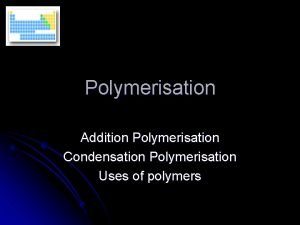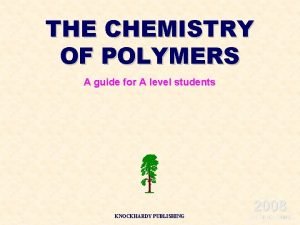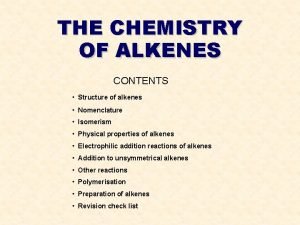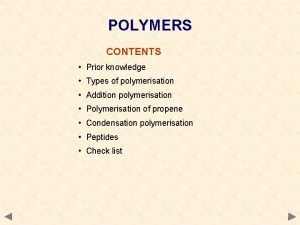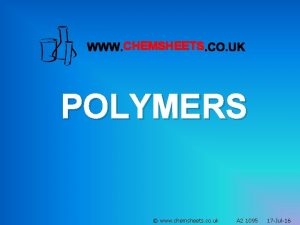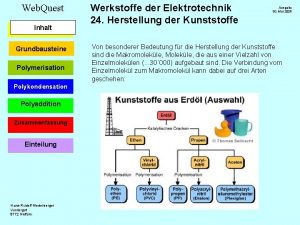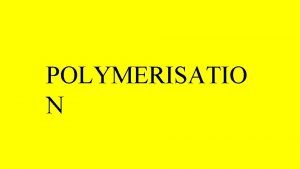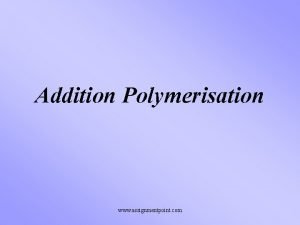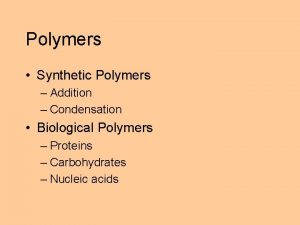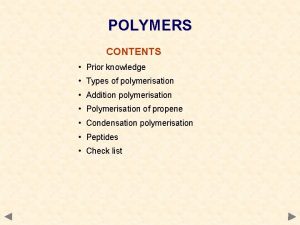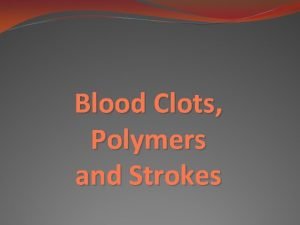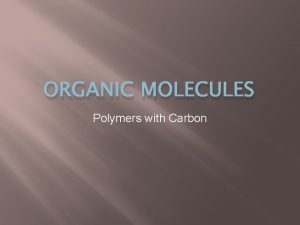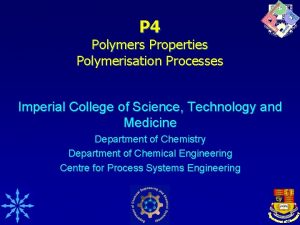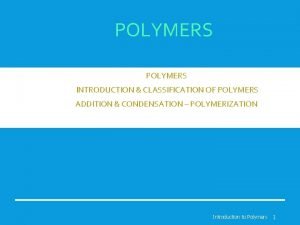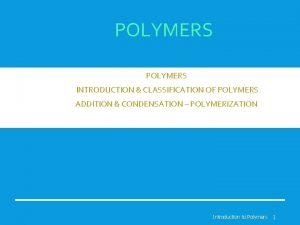THE CHEMISTRY OF POLYMERS AND ADDITION POLYMERISATION POLYMERS











- Slides: 11

THE CHEMISTRY OF POLYMERS AND ADDITION POLYMERISATION

POLYMERS CONTENTS • Prior knowledge • Types of polymerisation • Addition polymerisation • Polymerisation of propene

POLYMERS Before you start it would be helpful to… • know the functional groups found in organic chemistry • know the arrangement of bonds around carbon atoms • recall and explain electrophilic addition reactions of alkenes

POLYMERISATION General A process in which small molecules called monomers join together into large molecules consisting of repeating units. There are two basic types ADDITION 1. One monomer only 2. All the atoms in the monomer are used to form the polymer 3. The monomer repeatedly adds to itself over and over again CONDENSATION 1. 2 monomers join up alternatively along the polymer chain the with expulsion (elimination) of small molecules such as H 2 O and HCl 2. Not all the original atoms are present in the polymer Only Addition polymerisation is part of the CH 2 specification

ADDITION POLYMERISATION • all the atoms in the monomer are used to form the polymer • occurs with alkenes • mechanism can be free radical or ionic

POLYMERISATION OF ALKENES ADDITION POLYMERISATION Preparation Many are prepared by a free radical process involving high pressure, high temperature and a catalyst. The catalyst is usually a substance (e. g. an organic peroxide) which readily breaks up to form radicals which initiate a chain reaction. Another famous type of catalyst is a Ziegler-Natta catalyst (named after the scientists who developed it). Such catalysts are based on the compound Ti. Cl 4. Properties Physical varied by changing the reaction conditions (pressure, temperature etc). Chemical have chemical properties based on the functional groups in their structure. poly(ethene) is typical; it is fairly inert as it is basically a very large alkane. This means it is resistant to chemical attack and non-biodegradable.

POLYMERISATION OF ALKENES ADDITION POLYMERISATION Process • during polymerisation, an alkene undergoes an addition reaction with itself • all the atoms in the original alkenes are used to form the polymer • long hydrocarbon chains are formed the equation shows the original monomer and the repeating unit in the polymer n represents a large number ethene poly(ethene) MONOMER POLYMER

POLYMERISATION OF ALKENES ADDITION POLYMERISATION the equation shows the original monomer and the repeating unit in the polymer n represents a large number ethene poly(ethene) MONOMER POLYMER

POLYMERISATION OF ALKENES EXAMPLES OF ADDITION POLYMERISATION ETHENE PROPENE CHLOROETHENE POLY(ETHENE) POLY(PROPENE) POLY(CHLOROETHENE) POLYVINYLCHLORIDE TETRAFLUOROETHENE PVC POLY(TETRAFLUOROETHENE) PTFE “Teflon”

POLYMERISATION OF ALKENES SPOTTING THE MONOMER

POLYMERISATION OF ALKENES SPOTTING THE MONOMER
 Condensation and addition polymerisation
Condensation and addition polymerisation Addition polymerisation
Addition polymerisation Chemical properties of alkenes
Chemical properties of alkenes Propene addition polymerisation
Propene addition polymerisation Www.chemsheets.co.uk
Www.chemsheets.co.uk Addition polymers 2 chemsheets
Addition polymers 2 chemsheets Polymerisation polykondensation polyaddition tabelle
Polymerisation polykondensation polyaddition tabelle Polymerisatio
Polymerisatio Assignmentpoint.com
Assignmentpoint.com Phthalsäureanhydrid
Phthalsäureanhydrid Ib organic chemistry
Ib organic chemistry Organic vs inorganic chemistry
Organic vs inorganic chemistry
